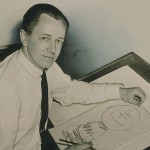
Charlie Brown
• First appearance: October 2, 1950. Charlie Brown started out around four years old, but aged to six in 1957, and later to eight years old.
• While Charles Schulz was teaching at the Art Instruction School in the late 1940s, he fell for a “red-haired girl”—an accountant named Donna Johnson. His heart was broken when she chose another man shortly before he was going to propose to her. As he did with so many other aspects of his life, Schulz used it in the comic strip. Over the course of the strip’s run, an unseen “red-haired girl” is the object of Charlie Brown’s unrequited love. Another of Johnson’s characteristics showed up in Peanuts, too: Like Charlie Brown, she often wore a pale yellow shirt with a black, horizontal zigzag going across it.
• Schulz was often asked if Charlie Brown was bald. “He’s got hair,” he responded. “It’s just so light you don’t notice it.”Snoopy
• First appearance: October 4, 1950. “Originally he was to be called Sniffy,” recalled Schulz, “but I was walking uptown one day and saw a comic magazine about a dog named Sniffy. On my way back to my job, I remembered that my mother had said, ‘If you ever have another dog, you should name him Snoopy.’ I thought, hey, why didn’t I think of that before?”
• Snoopy communicated (via a thought balloon) for the first time in 1952 and walked on two legs for the first time in 1956.
• On December 12, 1958, Snoopy first attempted to sleep on the top of his doghouse, but he fell off, and thought to himself, “Life is full of rude awakenings.” That awakening was great for Schulz, who made Snoopy’s doghouse a Peanuts character in its own right. He never showed it from any other angle but the side, and never showed the inside. (It’s said to be very roomy.)
• Over the decades, Snoopy’s various fantasy characters included Joe Cool, the World War I Flying Ace, Foreign Legionnaire, Beagle Scout, and the Literary Ace, whose first written words were: “It was a dark and stormy night.” In all of Peanuts history, Snoopy has taken on more than 150 different personas.Linus Van Pelt
• One day while Schulz was still teaching at the Art Instruction School in the early 1950s, he drew a little baby with wild hair and showed it to a friend named Linus Maurer. Maurer thought the kid looked funny, so Schulz decided to work him into the Peanuts strip, and call the boy Linus. He first appeared on September 19, 1952, as Lucy’s happy baby brother, but aged quickly as Schulz realized Charlie Brown needed a friendly ear.
• Seeing his own kids drag their blankets around the house, in 1956 Schulz gave one to Linus. Even though Linus “grew up” to school age, he never lost the need for it. Schulz was always proud of having introduced the term “security blanket” into the lexicon.
• Linus represented Schulz’s spiritual side, as the boy often quoted the Bible. As a young man in Minneapolis, Schulz was involved in the Church of God, but grew disillusioned with organized religion. Late in life he described himself as a “secular humanist.”
• Linus’s infatuation with the Great Pumpkin first played out around Halloween of 1959. “Linus, who is bright but very innocent,” explained Schulz, “got one holiday ahead of himself and confused Halloween with Christmas.”Lucy Van Pelt
• First appearance: March 3, 1952. Lucy was originally a baby, but her self-centered streak was there from the beginning. “Lucy comes from the part of me that’s capable of saying mean and sarcastic things,” Schulz said. She was originally modeled on Schulz’s daughter Meredith, whom he once described as a “fussbudget.”
• Nearly every autumn, Schulz would dedicate a Sunday strip to Charlie Brown’s attempt to kick a football held by Lucy, who invariably pulls it away at the last second—something that Schulz’s friends often did to him when he was a kid.Schroeder
• First appearance: May 30, 1951. Early in the strip, as a lark, Schulz wanted to show Charlie Brown singing the melody to Beethoven’s Ninth Symphony, so he copied the actual notes—clef and all—into the strip. He loved the way it looked, and searched for a way to keep using the musical staff. He thought of the toy piano that his young daughter liked to play and decided that one of the Peanuts cast should play one, too. So he chose his newest character, a baby he called Schroeder, who was named after a boy Schulz used to caddy with at a golf course in St. Paul.
• Although Schulz’s favorite composer was Brahms, he chose Beethoven to be Schroeder’s hero because the name “Beethoven” is intrinsically funnier than “Brahms.” (It also explains why Schroeder is so adamant about turning down Lucy’s advances: Beethoven was a lifelong bachelor, so Schroeder has to be one, too.)[…]
Patricia “Peppermint Patty” Reichardt
• Peppermint Patty debuted on August 22, 1966. It started when Schulz looked at a bowl of candy in his kitchen and was intrigued by the name “Peppermint Patty.” He decided to use the name for a character before another cartoonist did.
• Schulz liked Peppermint Patty—the way she didn’t understand that Snoopy was a dog (she called him “that funny-looking kid with the big nose,” and his dog house is “Chuck’s guest cottage”). He worked her into numerous story lines, giving her an outsider’s perspective, and believed she could “carry a strip all by herself.”
• Because of Peppermint Patty’s penchant for sleeping through school, in the 1980s researchers at Stanford University asked Schulz to send her to a narcolepsy clinic to help raise people’s awareness of the disorder. (She did go, but it was determined she was falling asleep in class because she stayed up too late at night.)
• Peppermint Patty’s troubles with schoolwork echoed Schulz’s. Both would rather draw, look out the window, sleep—anything that didn’t involve studying. She got a “D-minus” on just about every school project she attempted.[…]
Woodstock
• On April 4, 1967, a bird that resembled Woodstock haphazardly flew up to Snoopy’s doghouse and landed on his nose. Over the next four years, a series of birds regularly visited Snoopy and complained about various things, including the state of affairs for young people, Schulz’s nod to the growing Hippie movement. He was finally named in 1970 in honor of the Woodstock music festival.
• “I’ve held fast with Woodstock’s means of communication,” said Schulz, “though it has been tempting at times to have him talk. I feel it would be a mistake to give in on this point.”Franklin
• The first African-American kid in the Peanuts neighborhood, Franklin first appeared on July 31, 1968. It was the height of the Civil Rights movement, leading many fans to see it as a statement on desegregation. But Schulz said he never meant it that way. “I simply introduced Franklin as another character, not a political statement.” Schulz recalled an editor from the South who said, “I don’t mind you having a black character, but please don’t show them in school together.” Schulz ignored the request.
• Often playing the straight man, most of Franklin’s humor comes from his deadpan reactions to Peppermint Patty, who sits behind him at school, and to the other kids in Charlie Brown’s neighborhood, who are a bit too weird for his tastes.Pig-pen
• First appearance: July 13, 1954. Pig-Pen never really evolved beyond just being a complete mess, and Schulz, never wanting to force anything, gradually worked him out of the strip. The character did, however, have one lasting influence on society: When
scientists discovered that every kid really does have their own individual “pollution cloud,” they termed that cloud the “Pigpen effect.”[…]
Grown-ups
Why are there no adults shown in the Peanuts comic strips? “Well,” answers Schulz, “there just isn’t any room for them. They’d have to bend over to fit in the panels. If you added adults, you’d have to back off and it would change the whole perspective.”







